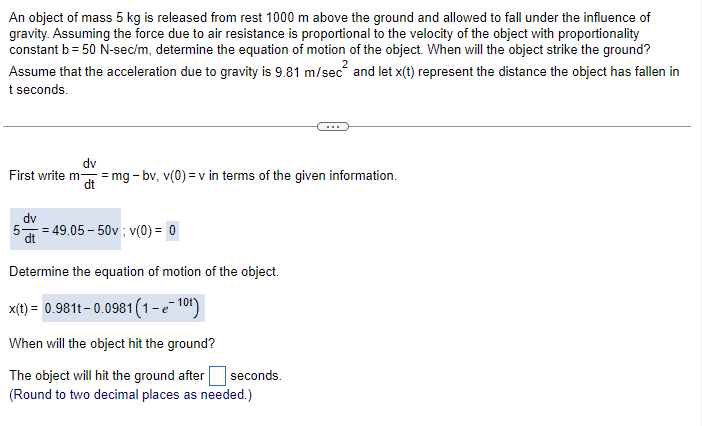An object of mass 5 kg is released from rest 1000 m above the ground and allowed to fall under the influence of gravity. Assuming the force due to air resistance is proportional to the velocity of the object with proportionality constant b = 50 N-sec/m, determine the equation of motion of the object. When will the object strike the ground? Assume that the acceleration due to gravity is 9.81 m/sec² and let x(t) represent the distance the object has faller t seconds. First write m = mg - bv, v(0)=v in terms of the given information. dv dt dv 5 = 49.05-50v; v(0) = 0 dt
An object of mass 5 kg is released from rest 1000 m above the ground and allowed to fall under the influence of gravity. Assuming the force due to air resistance is proportional to the velocity of the object with proportionality constant b = 50 N-sec/m, determine the equation of motion of the object. When will the object strike the ground? Assume that the acceleration due to gravity is 9.81 m/sec² and let x(t) represent the distance the object has faller t seconds. First write m = mg - bv, v(0)=v in terms of the given information. dv dt dv 5 = 49.05-50v; v(0) = 0 dt
Chapter3: Polynomial Functions
Section3.5: Mathematical Modeling And Variation
Problem 7ECP: The kinetic energy E of an object varies jointly with the object’s mass m and the square of the...
Related questions
Question
100%

Transcribed Image Text:An object of mass 5 kg is released from rest 1000 m above the ground and allowed to fall under the influence of
gravity. Assuming the force due to air resistance is proportional to the velocity of the object with proportionality
constant b = 50 N-sec/m, determine the equation of motion of the object. When will the object strike the ground?
2
Assume that the acceleration due to gravity is 9.81 m/sec² and let x(t) represent the distance the object has fallen in
t seconds.
dv
First write m- -mg-bv, v(0)= v in terms of the given information.
dv
549.05-50v; v(0) = 0
Determine the equation of motion of the object.
x(t) = 0.981t-0.0981 (1-e-1⁰t)
When will the object hit the ground?
The object will hit the ground after
(Round to two decimal places as needed.)
seconds.
Expert Solution
This question has been solved!
Explore an expertly crafted, step-by-step solution for a thorough understanding of key concepts.
Step by step
Solved in 2 steps

Recommended textbooks for you


Trigonometry (MindTap Course List)
Trigonometry
ISBN:
9781337278461
Author:
Ron Larson
Publisher:
Cengage Learning

College Algebra (MindTap Course List)
Algebra
ISBN:
9781305652231
Author:
R. David Gustafson, Jeff Hughes
Publisher:
Cengage Learning


Trigonometry (MindTap Course List)
Trigonometry
ISBN:
9781337278461
Author:
Ron Larson
Publisher:
Cengage Learning

College Algebra (MindTap Course List)
Algebra
ISBN:
9781305652231
Author:
R. David Gustafson, Jeff Hughes
Publisher:
Cengage Learning

Algebra & Trigonometry with Analytic Geometry
Algebra
ISBN:
9781133382119
Author:
Swokowski
Publisher:
Cengage